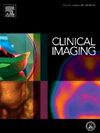Clinical and imaging aspects of pulmonary embolism: a primer for radiologists
IF 1.8
4区 医学
Q3 RADIOLOGY, NUCLEAR MEDICINE & MEDICAL IMAGING
引用次数: 0
Abstract
Although many advancements have been made in imaging modalities that can be used to diagnose pulmonary embolism (PE), computed tomography pulmonary angiography (CTPA) is still the preferred gold standard for promptly diagnosing pulmonary embolism by looking for filling defects caused by the embolus lodged within the main pulmonary artery or its respective branches. The diagnosis is made by the radiologists in emergency settings where quick detection of a PE on CTPA helps the Pulmonary Embolism Response Team (PERT) in quick management. Thus, utmost care is needed to follow standard image acquisition protocols and optimal contrast administration techniques to achieve a contrast opacification of at least 210 Hounsfield units for the radiologists to easily pinpoint an embolus within the pulmonary arteries. Even following proper CTPA scan acquisition guidelines, a CTPA image is prone to several artifacts that can be mistaken for a PE, resulting in a false positive read. In addition to this, many incidental findings, that can be the etiology of chest pain in a PE-suspected patient, are often overlooked by emergency radiologists who try to be as quick as possible in their read so that timely management of PE can be ensued. Taking this into account, our review paper provides the audience with a comprehensive understanding of the clinical aspects of pulmonary embolism and the imaging modalities used for PE detection. The main focus is on CTPA, its acquisition protocols, and the various incidental findings and artifacts to look for while interpreting a CTPA scan.
Précis
Beyond the filling defects, a CTPA scan should also be assessed by the radiologists for any incidental findings while keeping in mind several associated pitfalls and artifacts of CTPA.
肺栓塞的临床和影像学问题:放射科医生入门指南》(Clinical and imaging aspects of pulmonary embolism: a primer for radiologists)。
尽管可用于诊断肺栓塞(PE)的成像模式已取得了许多进展,但计算机断层扫描肺动脉造影术(CTPA)仍是及时诊断肺栓塞的首选金标准,它可通过观察栓子在主肺动脉或其相关分支内造成的充盈缺损来诊断肺栓塞。诊断由放射科医生在急诊环境中做出,CTPA 对肺栓塞的快速检测有助于肺栓塞应急小组(PERT)进行快速处理。因此,需要格外小心,遵循标准的图像采集协议和最佳的造影剂给药技术,以达到至少 210 Hounsfield 单位的造影剂不透明性,使放射科医生能轻松确定肺动脉内的栓子。即使遵循正确的 CTPA 扫描采集指南,CTPA 图像也很容易出现一些伪影,从而被误认为是 PE,造成假阳性读数。除此之外,急诊放射科医生往往会忽略许多偶然发现,而这些偶然发现可能是 PE 疑似患者胸痛的病因,他们会尽量加快读片速度,以便及时处理 PE。有鉴于此,我们的综述论文将让读者全面了解肺栓塞的临床方面以及用于检测肺栓塞的成像模式。重点是 CTPA、其采集协议以及在解读 CTPA 扫描时应注意的各种偶然发现和伪影。PRéCIS:除了充盈缺损外,放射科医生还应评估 CTPA 扫描的任何附带发现,同时牢记 CTPA 的一些相关误区和伪影。
本文章由计算机程序翻译,如有差异,请以英文原文为准。
求助全文
约1分钟内获得全文
求助全文
来源期刊

Clinical Imaging
医学-核医学
CiteScore
4.60
自引率
0.00%
发文量
265
审稿时长
35 days
期刊介绍:
The mission of Clinical Imaging is to publish, in a timely manner, the very best radiology research from the United States and around the world with special attention to the impact of medical imaging on patient care. The journal''s publications cover all imaging modalities, radiology issues related to patients, policy and practice improvements, and clinically-oriented imaging physics and informatics. The journal is a valuable resource for practicing radiologists, radiologists-in-training and other clinicians with an interest in imaging. Papers are carefully peer-reviewed and selected by our experienced subject editors who are leading experts spanning the range of imaging sub-specialties, which include:
-Body Imaging-
Breast Imaging-
Cardiothoracic Imaging-
Imaging Physics and Informatics-
Molecular Imaging and Nuclear Medicine-
Musculoskeletal and Emergency Imaging-
Neuroradiology-
Practice, Policy & Education-
Pediatric Imaging-
Vascular and Interventional Radiology
 求助内容:
求助内容: 应助结果提醒方式:
应助结果提醒方式:


